본 소개 논문은 Interdisciplinarity in Engineering International Conference에서 발행한 논문 "Improvement of the Die Casting Molds Cavities by Ceramic Surface Treatment"의 연구 내용입니다.
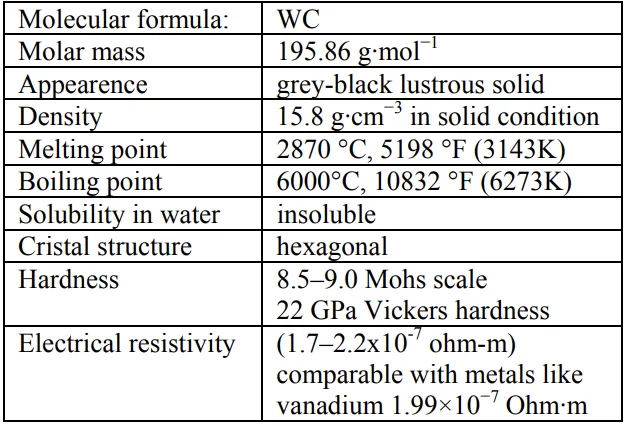
1. 개요:
- 제목: Improvement of the Die Casting Molds Cavities by Ceramic Surface Treatment (다이캐스팅 금형 캐비티의 세라믹 표면 처리 개선)
- 저자: Ferencz PETI, Lucian GRAMA, Ioan SOLOVĂSTRU
- 출판 연도: 2012
- 발표 저널/학회: Interdisciplinarity in Engineering International Conference
- 키워드: Mold, Aluminium, High Pressure Die Casting, Surface Treatment, Hard Surface (금형, 알루미늄, 고압 다이캐스팅, 표면 처리, 경질 표면)
2. 초록
금형의 주요 구성 요소인 캐비티와 인서트는 부품의 최종 형상을 결정하며, 주입된 알루미늄의 온도, 열 피로, 특히 인게이트(ingate) 영역에 나타나는 균열, 그리고 캐비티 내 고압으로 주입된 알루미늄으로 인한 언더컷 또는 언더워시(underwashes)로 인해 마모가 발생하여 수명이 제한됩니다.
3. 연구 배경:
연구 주제 배경:
다이캐스팅 금형의 수명은 마모, 열 피로, 균열(특히 인게이트 영역)에 의해 제한됩니다. 이러한 문제는 주입된 알루미늄의 고온 및 고압으로 인해 발생합니다.
이전 연구 현황:
이전 연구에서는 다양한 재료와 코팅 기술을 포함하여 금형 수명을 개선하기 위한 다양한 방법을 조사했습니다.
연구 필요성:
알루미늄 흐름으로 인한 언더워시가 발생하기 쉬운 영역, 특히 다이캐스팅 금형의 수명과 저항성을 개선해야 할 필요성이 지속적으로 제기되고 있습니다.
4. 연구 목적 및 연구 질문:
연구 목적:
금형의 수명을 늘리고 인게이트 영역의 저항성을 개선하여 알루미늄 플럭스로 인한 언더워시를 줄이는 것입니다.
핵심 연구:
"rocklinizer" 방법을 사용하여 금형의 활성 요소에 얇은 세라믹 재료(텅스텐 카바이드 또는 티타늄 카바이드)를 적용하는 방법을 조사합니다.
5. 연구 방법
본 연구는 다이캐스팅 금형에 경질 표면 처리를 적용하는 재료, 장비 및 공정을 설명합니다. 이 방법은 "rocklinizing"이라고 명명되었습니다. 사용된 재료는 텅스텐 카바이드와 티타늄 카바이드입니다. 이러한 재료의 화학적, 물리적 특성을 포함한 특성이 자세히 설명되어 있습니다. 사용된 장비는 Rocklinizer이며 다양한 모델과 전극 옵션이 제공됩니다. 적용 공정은 금형의 금속 표면에 내마모성 재료를 전자적으로 함침 및 증착하는 것을 포함합니다.
6. 주요 연구 결과:
주요 연구 결과 및 제시된 데이터 분석:
- 텅스텐 카바이드(WC)와 티타늄 카바이드(TiC)는 높은 경도, 내마모성 및 열 안정성으로 인해 경질 표면 처리에 적합한 재료로 확인되었습니다.
- Rocklinizer 장비 및 공정을 통해 이러한 재료를 금형의 활성 표면에 적용할 수 있습니다.
- Rocklinizer 공정은 금속 표면 아래와 위에 재료를 증착하여 상당한 열 발생 없이 강한 결합을 생성합니다.
- 이 공정은 공구 수명을 연장하고 가동 중지 시간을 줄여 생산성을 높이고 비용을 절감할 수 있습니다.
- 게이트 채널, 코어 및 솔더링(soldering)이 발생하기 쉬운 영역을 포함하여 금형의 특정 적용 영역이 확인되었습니다.
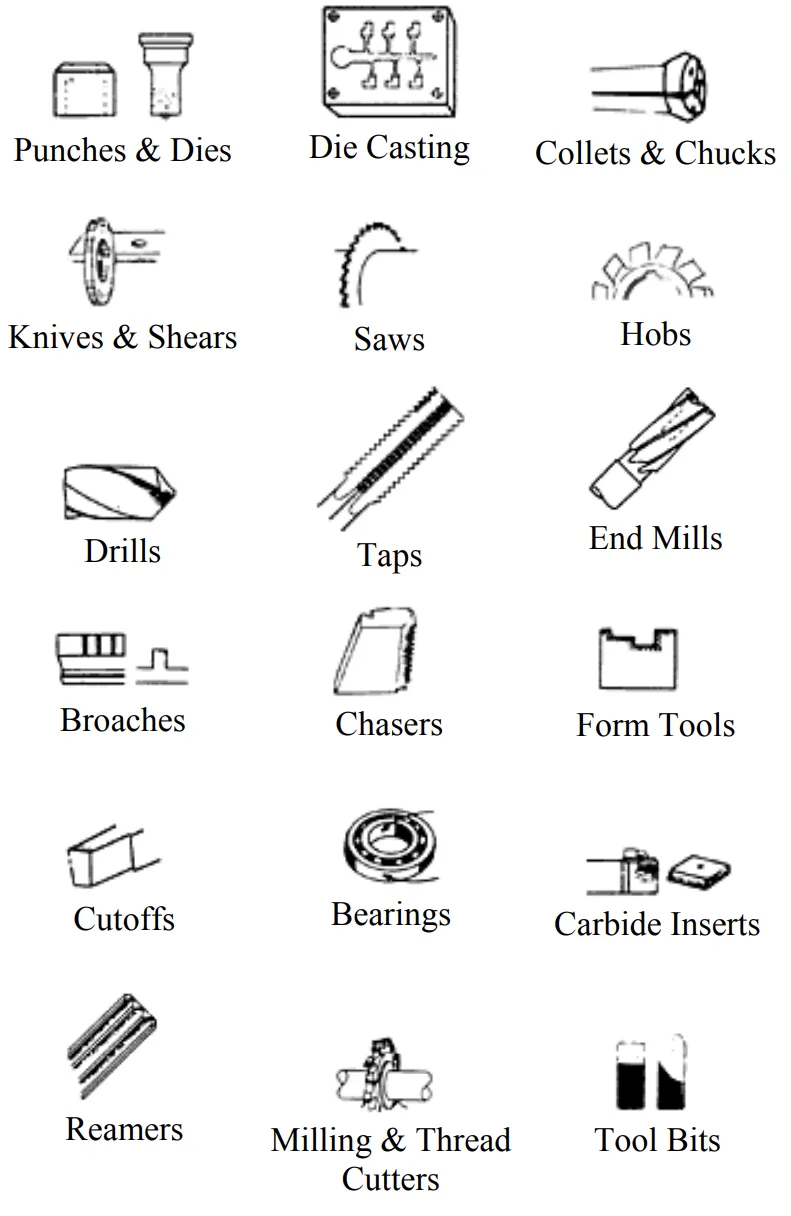
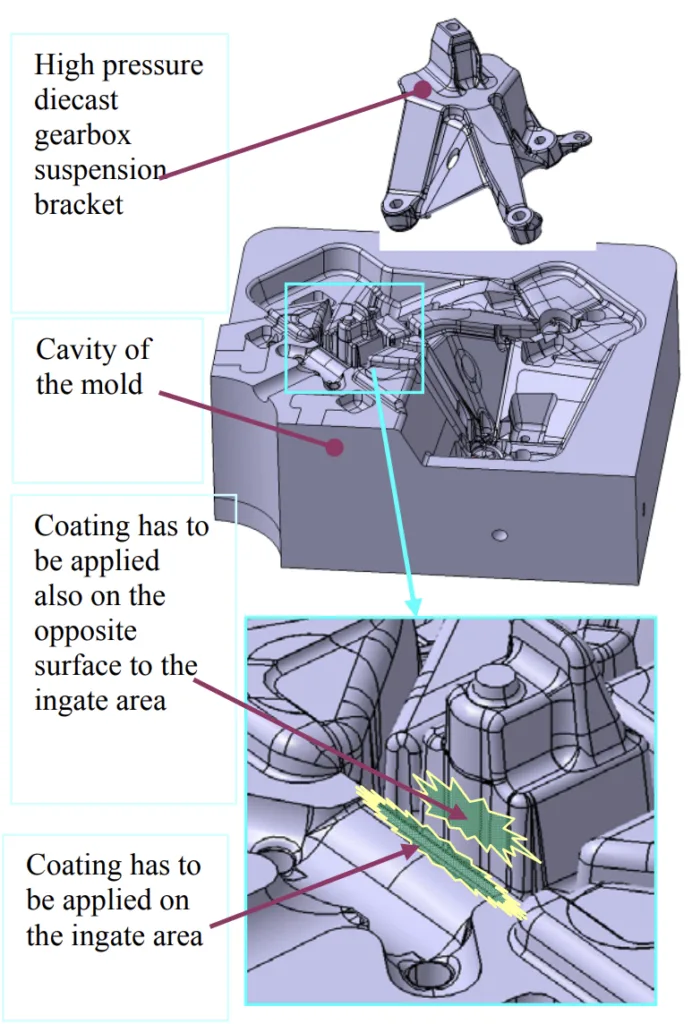
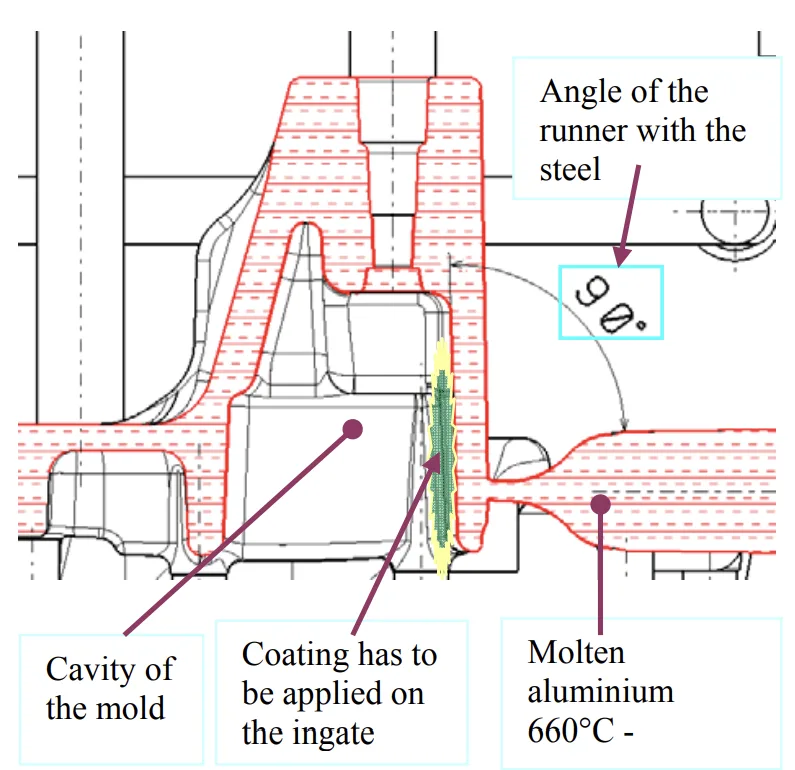
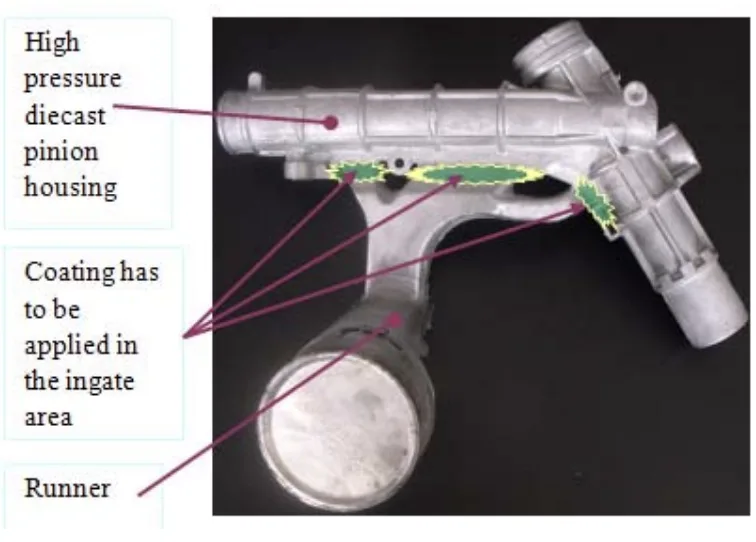
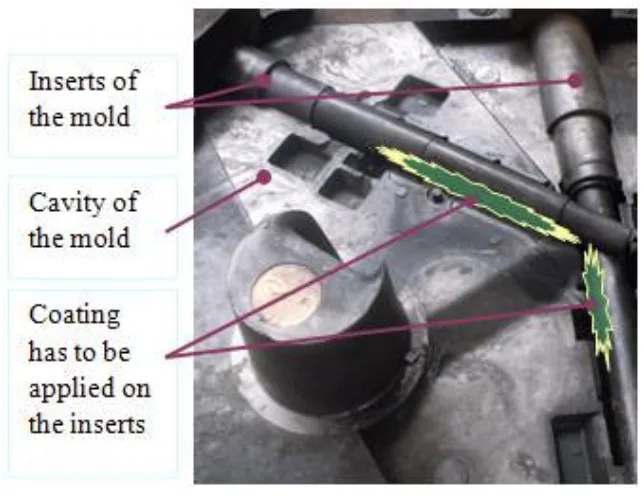
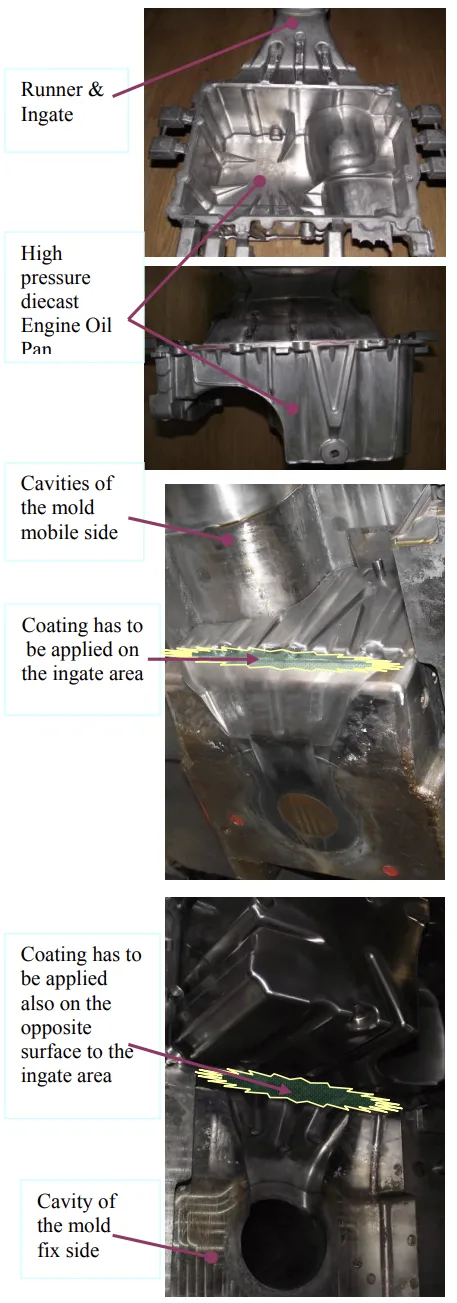
그림 이름 목록:
- Fig. 1 - Tungsten carbide structure (텅스텐 카바이드 구조)
- Fig. 2 - The molecular structure of the titan carbide TiC (티타늄 카바이드 TiC의 분자 구조)
- Fig. 3 - Coated areas in the case of a HPDC mould for a gearbox suspension bracket (기어박스 서스펜션 브래킷용 HPDC 금형의 코팅 영역)
- Fig. 4 - Orientation of the molten aluminium to the steel of the mould (금형 강철에 대한 용융 알루미늄의 방향)
- Fig. 5 - Coated areas in the case of a HPDC mould for a pinion housing (피니언 하우징용 HPDC 금형의 코팅 영역)
- Fig. 6 - Coated areas in the case of a HPDC mould for a pinion housing (피니언 하우징용 HPDC 금형의 코팅 영역)
- Fig. 7 - Coated areas in the case of a HPDC mould for an engine oilpan (엔진 오일 팬용 HPDC 금형의 코팅 영역)
7. 결론:
주요 연구 결과 요약:
텅스텐 카바이드 또는 티타늄 카바이드를 사용하는 Rocklinizer 방법은 다이캐스팅 금형에 경질 및 내마모성 표면을 효과적으로 적용할 수 있습니다. 이 처리는 금형 수명을 연장하고 마모를 줄이며 솔더링과 같은 문제를 최소화하여 궁극적으로 생산성을 향상시키고 비용을 절감할 수 있습니다. 이 방법의 적용은 인게이트와 같이 마모가 심한 영역에서 특히 유용합니다.
8. 참고 문헌:
- [1] ERNST, B., (1991), Praxis der Druckgussfertigung, Ed. Schiele & Schön, Berlin, Germany
- [2] HERBERT, R., (2002), Mold Engineering, Ed. Carl Hanser Verlag, Munich, Germany
- [3] Faisal, F., Gyuyeol, B., (2011), Evaluation of Die-Soldering and Erosion Resistance of High Velocity Oxy-Fuel Sprayed MoB-Based Cermet Coatings, Journal of Thermal Spray Technology, Volume 20, Number 5, Pages 1022-1034
- [4] GRAMA, L., PETI, F., (2009), Analyze of the opportunities of the coating of the active elements of the high pressure die casting molds, Ed. UORADEA, Romania
- [5] MIHĂILĂ, I., (2003), Tehnologii Neconvenționale, Ediția II, Ed. Universității din Oradea, Romania
- [6] MONTES, J., (2008), Revision Tecnica del Producto, CIE C. Vilanova, Spain
- [7] NANU, A., (2003), Tratat de tehnologii neconvenționale, Vol.1, Tehnologii neconvenționale la început de mileniu, Ed. Angusta, Timişoara, Romania
- [8] STREET, A., (1977), The diecasting handbook, Portcullis Press LTD, UK
- [9] Ugues, D., (2006), Hard coatings to prevent the washout phenomena in high pressure die casting tools, Ed. BHM Berg- und Hüttenmännische Monatshefte, Volume 151, Number 3, Pages 109-112
- [10] Woon, Y.K., (2004), Development of a die design system for die casting, The International Journal of Advanced Manufacturing Technology, Volume 23, Numbers 5-6, Pages 399-411
- [11] The Society of Manufacturing Engineers website, (2012), [Online]. Available: http://www.sme.org
- [12] The Rocklin Manufacturing co. Website, (2012), [Online]. Available: http://www.rocklinmanufacturingco.com
- [13] The Wikipedia website, (2012), [Online]. Available: http://en.wikipedia.org/wiki/Die_casting
- [14] The CIE Automotive website, (2011), [Online]. Available: http://ciepedia.cie.lan/ciepedia/index.php
- [15] The North American Die Casting Association website, (2012), [Online]. Available: http://www.diecasting.org
- [16] Casting of Light Metals, (2007), Engineering Materials and Processes, Casting: An Analytical Approach, Pages 1-12
- [17] Norma Ingenieria NCV21007B, (2006), Velocidad en el ataque, CIE C. Vilanova, Spain
- [18] Part Design, (2007), Engineering Materials and Processes, Casting: An Analytical Approach, Pages 43-96
- [19] Procedimiento IDT 05/1, (2007), Cuaderno de cargas de moldes, rev05, CIE Inyectametal, Spain
- [20] Process Design, (2007), Engineering Materials and Processes, Casting: An Analytical Approach, Pages 97-155
9. 저작권:
- 본 자료는 "Ferencz PETI, Lucian GRAMA, Ioan SOLOVĂSTRU"의 논문 "Improvement of the Die Casting Molds Cavities by Ceramic Surface Treatment"을 기반으로 합니다.
- 논문 출처: 본 논문에서는 언급되지 않았습니다.
본 자료는 위 논문을 소개하기 위해 작성되었으며, 상업적 목적으로 무단 사용하는 것을 금합니다. Copyright © 2025 CASTMAN. All rights reserved.